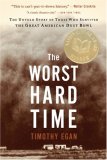Summary | Excerpt | Reviews | Beyond the Book | Readalikes | Genres & Themes | Author Bio
The Untold Story of Those Who Survived the Great American Dust Bowl
by Timothy Egan

Critics' Opinion:
Readers' Opinion:
First Published:
Dec 2005, 320 pages
Paperback:
Sep 2006, 352 pages
 Book Reviewed by:
Book Reviewed by:
BookBrowse Review Team
Buy This Book
Seasoned XIT ranch hands scoffed at such claims; the demo
projects were a scam, cowboys said. They warned anybody who would listen
that the Panhandle was no place to break the sod. Dust mulch? How was
that supposed to hold moisture in the ground, with the wind blowing steady at
thirty clicks an hour? The land was high and cold, with little drainage, and
nearly treeless in its entirety. As for rainfall, the average in the county was
about sixteen inches a year, not enough, by any traditional standards, to
sustain a crop. At Dalhart, the elevation was 4,600 feet. A blue norther would
come down from Canada through the Rockies and shake a person to their
bones. The Panhandle was good for one thing only: growing grass — God's
grass, the native carpet of plenty. Most of the land was short buffalo grass,
which, even in the driest, most wind-lacerated of years, held the ground in
place. This turf had supported the southern half of the great American bison
herd, up to thirty million animals at one point.
The best side is up, the cowboys said time and again — for
chrissakes don't plow it under. Nesters and cowboys hated each other; each
side thought the other was trying to run the other off the land. Homesteaders
were ridiculed as bonnet-wearing pilgrims, sodbusters, eyeballers,
drylanders, howlers, and religious wackos. Cowboys were hedonists on
horseback, always drunk, sex-starved. The cattle-chasers were consistent in
one way, at least. They tried telling nesters what folks at the XIT had passed
on for years, an aphorism for the High Plains:
"Miles to water, miles to wood, and only six inches to hell."
The syndicate had bondholders in London to satisfy. By 1912, the
last of the XIT cattle were off the land, and the ground that was leveraged to
build the state capitol of Texas had ceased to function as a working ranch.
Four years later, Charlie Goodnight held what he called "the last buffalo hunt"
on his ranch in Palo Duro Canyon. More than ten thousand people showed
up to watch the old cowboy chase an imported buffalo, a limp choreography.
When Bam White and his family crossed over into Texas in 1926, only
450,000 acres were unplowed of the original three-million-acre XIT.
The family spent the next night in north Dallam County, a day's ride from
Dalhart. The thunderheads had missed them, passing farther east. Bam
White rose in the winter darkness and gave his horse team another pep talk.
We're in Texas now, keep on a-going, one leg at a time. You got
us outta Colorado. You got us outta Oklahoma. Now get us through Texas to
Littlefield, and a new home.
They had crossed into one of the highest parts of the High Plains,
where the wind had its way with anything that dared poke its head out of the
ground, and it was .atter even than Oklahoma. Lizzie White wondered again
why anyone — white, brown, or red — would choose to live in this country,
the coldest part of Texas. Even the half-moon, icy at night, looked more
hospitable than this hard ground. As they said on the XIT, only barbed wire
stood between the High Plains and the North Pole.
The Whites arrived in Dalhart on February 26, 1926. Bam found a
place to camp at the edge of town and took to fretting again. Littlefield was
still 176 miles to the south. The family was down to the last of their dried
food, and they didn't know a soul. It was not the first time a family with
significant Indian blood had returned to the old treaty lands. Comanche,
Kiowa, and Apache who had drifted back lived a shadowed existence,
dressed like whites, going by names like "Indian Joe" and "Indian Gary." As
long as they stayed largely invisible, nobody paid much attention to them.
Indians were not citizens yet. They could be forcefully removed to a
reservation. Any hint of their earlier presence was gone, erased for the new
tomorrow. Dalhart had no history beyond the XIT; what came before was
viewed as having little merit.
Copyright © 2005 by Timothy Egan. Reprinted by permission of Houghton Mifflin Company.





The Funeral Cryer by Wenyan Lu
Debut novelist Wenyan Lu brings us this witty yet profound story about one woman's midlife reawakening in contemporary rural China.
Your guide toexceptional books
BookBrowse seeks out and recommends the best in contemporary fiction and nonfiction—books that not only engage and entertain but also deepen our understanding of ourselves and the world around us.